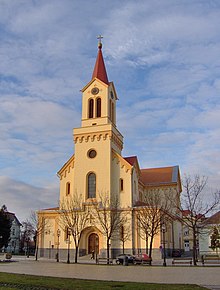Diocese of Zrenjanin
| Diocese of Zrenjanin | |
| Basic data | |
|---|---|
| Country | Serbia |
| Ecclesiastical province | Church Province of Belgrade |
| Metropolitan bishopric | Archdiocese of Belgrade |
| Diocesan bishop | László Német SVD |
| Vicar General | Mellár József |
| surface | 9,387 km² |
| Dean's offices | 4 (December 31, 2014 / AP2016 ) |
| Parishes | 38 (December 31, 2014 / AP2016 ) |
| Residents | 804,000 (December 31, 2014 / AP2016 ) |
| Catholics | 70,500 ( 12/31/2014 / AP2016 ) |
| proportion of | 8.8% |
| Diocesan priest | 19 (December 31, 2014 / AP2016 ) |
| Religious priest | 6 (December 31, 2014 / AP2016 ) |
| Catholics per priest | 2,820 |
| Permanent deacons | 1 (December 31, 2014 / AP2016 ) |
| Friars | 7 (December 31, 2014 / AP2016 ) |
| Religious sisters | 8 (December 31, 2014 / AP2016 ) |
| rite | Roman rite |
| Liturgical language | Hungarian , Serbian , Croatian , German |
| cathedral | John Nepomuk Cathedral |
| Website | www.catholic-zr.org.rs |
The Diocese of Zrenjanin ( Latin Dioecesis Zrenianensis ) is a Roman Catholic diocese in Serbia with its seat in Zrenjanin .
László Német has been Bishop of Zrenjanin since 2008 .
Diocese history
The present diocese area of Zrenjanin was under jurisdiction and church history until the end of the First World War to the Hungarian Roman Catholic diocese of Szeged-Csanád . As a result of the Trianon Peace Treaty of June 4, 1920, the territory of the Szeged-Csanád diocese was divided into three parts between Hungary , Romania and Yugoslavia . The part of the diocese stretching along the rivers Tisza and Danube fell to Yugoslavia.
Since February 10, 1923, an apostolic administrator was specially commissioned for the diocese area annexed to Yugoslavia and the Apostolic Administratur Banat , ( Apostolic Administratur Yugoslav Banat ), was canonically established. The first apostolic administrator was the Croatian Franciscan Rafael Rodić and later Archbishop of the Roman Catholic Archdiocese of Belgrade . Commissioned by the Holy See , the Croat Josip Antun Ujčić succeeded Rodić in 1936 and became the new Apostolic Administrator of the Apostolic Administration of the Yugoslav Banat, as well as the new Archbishop of Belgrade .
During and after the end of the Second World War , the Apostolic Administration of the Yugoslav Banat lost many Roman Catholic Christians (mostly the ethnic Germans ). Overall, caused by the turmoil of the Second World War and afterwards, the proportion of Roman Catholic Christians fell from around 206,000 to 120,000 believers. Among them, especially between 1945 and 1960, the members of the German minorities ( Donauschwaben / Banatdeutsche ) left the diocese area. Of the 64 parishes that existed before the beginning of the Second World War, 40 are currently preserved. Four of the eight existing deaneries .
On July 17, 1961, the Holy See appointed the Greek Catholic Pastor Gabrijel Bukatko as the apostolic administrator of the Apostolic Administration of the Yugoslav Banat as coadjutor and successor to Josip Antun Ujčić . Since most of the Roman Catholic Christians in the Diocese of Zrenjanin can be attributed to the Hungarian nationality, the Holy See decided to appoint the Hungarians Tamás Jung , born in the Banat area, as apostolic administrator on December 22, 1971.
On December 16, 1986, the Apostolic Administration of the Yugoslav Banat was raised to the Bishopric of Zrenjanin. During this time, the Archdiocese of Belgrade and the ecclesiastical province of Belgrade were founded. Accordingly, the newly founded diocese of Zrenjanin became a suffragan diocese alongside the diocese of Subotica . On January 7, 1988, the first diocesan bishop , the Hungarian László Huzsvár, was appointed . The solemn offering of the Holy Sacrament took place on February 14, 1988 in the Cathedral of Zrenjanin. After a year vacancy of the episcopal see, Pope Benedict XVI. on April 23, 2008 László Német SVD as the new Shepherd of Zrenjanin. He received the episcopal ordination on July 5, 2008 by Péter Cardinal Erdő , Archbishop of Esztergom and Primate of Hungary, in the Zrenjanin Cathedral of St. John Nepomuk .
See also
Web links
- Entry for the Diocese of Zrenjanin on catholic-hierarchy.org
- Official diocese website and diocese history (Serbian, Hungarian, English)

